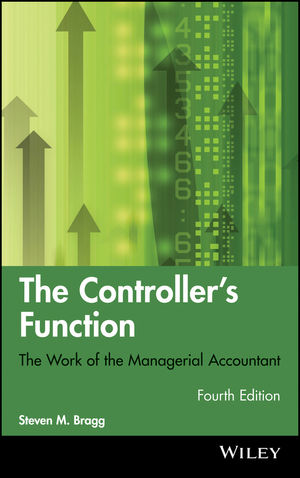The Controller's Function: The Work of the Managerial Accountant, 4th EditionISBN: 978-0-470-93742-6
Hardcover
496 pages
March 2011
 This is a Print-on-Demand title. It will be printed specifically to fill your order. Please allow an additional 15-20 days delivery time. The book is not returnable.
|
||||||
Preface xi
Chapter 1: The Controller’s Job 1
Main Job Functions 1
Job Description 2
Job Qualifications 5
Organizational Structure of the Accounting Department 6
Ethics 11
Chapter 2: Internal Control 13
Basic Elements 13
Controls to Use in Your Business 20
Elements of Internal Accounting Control 48
Levels of Controls 49
Fraud 50
Auditing for Fraud 54
Notes 55
Chapter 3: Planning and the Strategic Plan 56
Strategic Plan Overview 56
System of Plans 59
Planning Cycle 60
Planning Roles 62
Planning Timing and the Planning Period 63
Business Mission 65
Developing Long-Range Objectives 67
Developing Long-Range Strategies 69
Chapter 4: Long-Range Financial Plan 73
Layout and Purpose 73
Trends of Revenues and Profits 75
Capital Investments 76
Cash Flows and Financing Requirements 77
Risk Analysis 78
Breakdown by Business Unit/Product Line/Geography 81
Financial Position 81
Chapter 5: Annual Plan 87
System of Plans 87
Additional Budget Modeling Topics 100
Annual Planning Cycle 102
Role of the Controller 103
Sales Planning: The Base of All Business Plans 103
Steps in Developing the Near-Term Sales Plan 104
Methods for Determining the Sales Forecast 105
Changes in the Sales Mixture 109
Changes in the Sales Price 111
Changes in the Cost 112
Chapter 6: Sales 114
Role of the Controller 114
Sales Analysis 116
Sales Standards 120
Sales Reports 122
Product Pricing 125
Chapter 7: Distribution Expenses 132
Role of the Sales Manager 133
Analyzing Distribution Costs 133
Analyzing by Application 135
Setting the Distribution Budget 141
Chapter 8: Direct Materials and Labor 148
Objectives 148
Role of the Controller 149
Types of Cost Systems 152
Measuring Direct Material Costs 153
Controlling Direct Material Costs 154
Controlling Direct Material Quantities 155
Measuring Direct Labor Costs 158
Controlling Direct Labor Costs 159
Target Costing 165
Chapter 9: Overhead 167
Need for Overhead Controls 168
Responsibilities of the Controller 169
Account Classifications 170
Fixed and Variable Costs 172
Cost Allocation 178
Controlling Overhead 186
Production Reports 190
Chapter 10: General and Administrative Expenses 193
Functions Involved 193
Accounting for and Allocating Administrative Expenses 194
Responsibility Accounting 196
“Unique” Expenses 197
Controlling Costs 199
Chapter 11: Cash and Investments 202
Objectives of Cash Management 202
Role of the Controller 203
Cash Collections 204
Cash Disbursements 207
Investment of Short-Term Funds 208
Accounting for Records of Investment 210
Cash and Investment Controls 214
Chapter 12: Receivables 221
Functions of the Credit Department 221
Shortening the Receivables Cycle 225
Reserve for Doubtful Accounts 227
Receivables Fraud and Control 227
Chapter 13: Inventory 229
Inventory Management Systems 229
Inventory Tracking 235
Physical Inventory Procedure 241
Inventory Valuation 244
Inventory Fraud and Controls 247
Chapter 14: Property, Plant, and Equipment 251
Role of the Controller 252
Capital Budgeting 253
Postproject Appraisals 267
Other Aspects of Fixed Assets 268
Chapter 15: Liabilities 271
Objectives 271
Controls 272
Credit Agreement Provisions 274
Debt Capacity 275
Bond Ratings 276
Leverage 278
Chapter 16: Equity 281
Role of the Controller 281
Cost of Capital 282
Dividend Policy 290
Long-Term Equity Planning 291
Repurchasing Common Shares 298
Capital Stock Records 299
Chapter 17: Operational Accounting 301
Create Departmental Job Descriptions 301
Create a Departmental Training Program 303
Clear Out Excess Documentation 306
Streamline the Accounting Workflow 307
Document All Major Processes 309
Schedule the Department 310
Correct the Underlying Causes of Errors 312
Use of Best Practices 314
Outsourcing Selected Accounting
Functions 316
Chapter 18: The Fast Close 322
Different Types of Fast Close 323
How to Achieve a Fast Close 324
Enhanced Closing Process 339
Summary 339
Chapter 19: SEC Filings 341
Form 8-K 341
Annual 10-K and Quarterly 10-Q Reports 348
Timing of Annual and Quarterly Report Filings 350
Form S-1 351
Form S-3 352
Form S-8 353
Forms Requiring Payment to the SEC 354
Fedwire Payments 355
Chapter 20: Performance Measurements and Trends 356
Performance Measurements 357
Trends 373
Interrelationship of Ratios 375
Just-in-Time Ratios 375
Chapter 21: Financial Analysis 378
Analyzing Financial Statements 378
Analyzing Working Capital 385
Analyzing Financing Options 391
Services Profitability Analysis 394
The Throughput Analysis Model 397
Production Outsourcing Decision 399
New Product Decision 401
Chapter 22: Cost Reduction 404
Types of Reports Used for Cost Reduction Analysis 404
Spend Analysis Overview 408
Spend Database 409
Supplier Consolidation Analysis 410
Parts Consolidation Analysis 412
Maintenance, Repair, and Operations Item Analysis 412
Spend Compliance 413
Spend Analysis Reports 414
Workforce Reduction Analysis 417
Workforce Reduction Issues 421
Workforce Reduction Alternatives 422
5S Analysis 423
Check Sheets 424
Error Quantification 424
Fixed Cost Analysis 426
Ishikawa Diagrams 427
Value Stream Mapping 427
Waste Analysis 430
Chapter 23: Taxes 432
Tax Strategy 433
Tax Organization 434
Role of the Tax Manager 436
Tax Records 437
Tax versus Book Accounting 440
Sales and Use Taxes 441
Proper Classification of Accounts 442
Chapter 24: Selecting a Financial Information System 444
Reasons to Purchase Software 445
Defining Systems Requirements 445
Existing System Documentation 448
Joint Sessions 449
Preparing the Request for Proposal 452
Distribution of the Request for Proposal 457
Review of the Vendor’s Completed Proposal 458
Reference Calls 462
Demonstration 463
Site Visits 463
Cost of the System 464
Final Selection 465
Contract Negotiations 465
Postimplementation Review 466
Appendix New Controller Checklist 469
About the Author 477
Index 479



